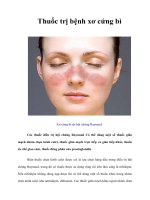Bài Giảng Xơ Cứng Bì Y Hà Nội
Bạn đang xem bản rút gọn của tài liệu. Xem và tải ngay bản đầy đủ của tài liệu tại đây (10.34 MB, 70 trang )
XƠ CỨNG BÌ
TS. BS Hoàng Thị Lâm
Phó Trưởng Bộ môn Dị ứng - MDLS, Đại học Y Hà nội
Khoa khám bệnh, bệnh viện Đại học Y Hà nội
Definition
1. Systemic sclerosis (scleroderma)
a multisystem disorder characterized by
1) functional and structural abnormalities of
blood vessels
2) fibrosis of the skin and internal organs
3) immune system activation
4) autoimmunity
Epidemiology
1. Prevalence: Rare disease
4-12 new cases per million per year
prevalence of 19-75/100,000
2. Susceptibility: host factor
age - peak occurrence: age 35-65 years
rare in children
gender - female : male = 3-12 : 1
genetic background:
Classification
Scleroderma
Localized
Scleroderma
Morphea
Linear
Scleroderma
Systemic
Scleroderma
(Systemic Sclerosis)
Limited
Scleroderma
Diffuse
Scleroderma
Sine
Scleroderma
4
Limited and Diffuse SSc—
Skin Involvement
Limited
Diffuse
5
Limited Cutaneous
Previously called CREST
Involvement of distal extremities and face/neck
Raynaud’s phenomenon for years prior to skin thickening
Occasionally pulmonary hypertension with or without
interstitial lung disease
Majority anti-centromere antibody positive
(80–90%)
Nailfold capillaroscopy—dilated capillary loops
* CREST syndrome
- calcinosis, Raynaud's phenomenon, esophageal
dysmotility, sclerodactyly, telangiectasia
6
Diffuse Cutaneous
Widespread with early involvement of internal
organs
Raynaud’s phenomenon
Truncal and acral skin involvement
Absent for anti-centromere antibody
Nailfold capilaroscopy—capillary dilatation and
destruction
7
Diffuse Cutaneous
Associated with substantial morbidity and
mortality resulting from—
– Vascular dysfunction
– Organ fibrosis and inflammation
– Gastrointestinal dysmotility
– Myocardial involvement
8
Etiology
Environmental factors
1) silica dust
2) organic solvents
3) biogenic amines
4) urea formaldehyde
5) polyvinyl chloride
6) rapeseed oil
7) bleomycin
8) L-tryptophan
9) silicone implant (?)
Genetic predisposition
Defective immunoregulation
1) cell mediated immunity
CD4/CD8 , cytokines
2) humoral immunity
– hypergammaglobulinemia
– autoantibody production
– antinuclear antibody (+) >
95%
Pathogenesis
Susceptible host
Exogenous events
Immune system activation
Fibroblast
activation
Endothelial cell
activation/damage
End stage pathology
Obliterative vasculopathy
Fibrosis
Pathogenesis
1. Vasculopathy of small artery and capillary
- endothelial cell injury
- adhesion and activation of platelet
- PG F, thromboxane A2 release
- vasoconstriction & growth of endothelial cell and
fibroblast
- narrowing or obliteration, increased permeability
2. Fibrosis
- aberrant regulation of fibroblast cell growth
- increased production of extracellular matrix
(collagen, fibronectin, and glycosaminoglycan)
- thickening of the skin & fibrosis of internal organs
Vascular abnormalities
1) Raynaud's phenomenon
- cold hands and feet
with reversible skin color change (white to blue to red)
- induced by cold temperature or emotional stress
- initial complaint in 3/4 of patients
- 90% in patients with skin change
(prevalence in the general population: 4-15%)
2) digital ischemic injury
Raynaud’s phenomenon
Raynaud’s phenomenon
Raynaud’s phenomenon
• Arteriogram
- narrowing and
occlusion of digital
arteries
- proximal vessels,
arcades and metacarpal
vessels are widely patent
Causes of Raynaud’s
Occlusive arterial disease
Rheumatic
diseases:Scleroderma,CREST,MCTD,SLE
,RA, Myositis
Repetitive vascular injury
Hyperviscosity
:Polycythemia,Cryoglobulinemia
Thoracic outlet syndrome
Telangiectasia
• local disruption of
angiogenesis
• blanched by pressure
Dilated capillaries seen
over the face
Skin involvement
1) stage
- edematous phase
- indurative phase
- atrophic phase
2) firm, thickened bound to underlying soft tissue
3) decrease in range of motion, loss of facial expression,
inability to open mouth fully, contractures
4) ulceration, loss of soft tissue of finger tip, pigmentation,
calcific deposit, capillary change
Edematous phase
Skin Induration
Acrosclerosis
Skin changes,and flexion contactures
Facial changes
Tight, thin lips with vertical perioral furrows
Salt and pepper pigmentation
Musculoskeletal system
• Polyarthritis and flexion contracture
• Muscle weakness and atrophy (primary
/secondary)
Terminal digit resorption









